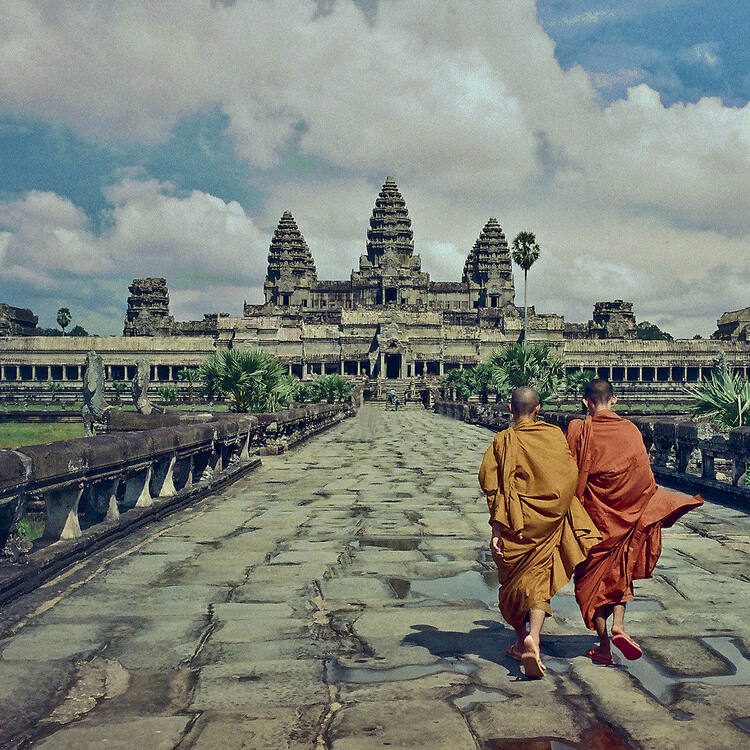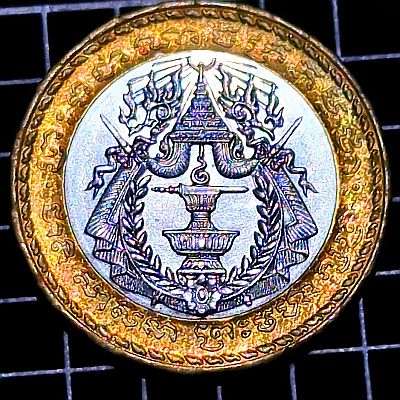A coin from the heir to the mighty empire of Angkor

(Image of Buddhist monks walking towards the famous Angkor Wat temples, Cambodia, from Unesco.com)
Archaeological data has revealed that the area we now call “Cambodia” was inhabited by human beings at least 40,000 years ago. Cities developed along the coast in the centuries before and after the birth of Christ. Indian and Chinese pilgrims and traders passed through these cities, and for the first centuries of the Christian era sources for Cambodian history that survive are almost entirely written in Chinese. Elements of Indian culture, in the meantime, took root among Cambodia’s elite, and by the 5th and 6th centuries several Hinduized kingdoms sprang up in southern Cambodia. We know about them from the remains of small religious monuments in brick, laterite and stone, from massive stone sculptures, and from inscriptions in Sanskrit and Cambodian, or Khmer. The earliest dated inscription comes from the 4th century AD.
The “Angkor” temples were at the heart of the Khmer Empire, which reigned from the beginning of the 9th century to the end of the mid-15th century.
At its height, the Empire’s population was around one million; today’s Myanmar, Laos, Vietnam and Malaysian Peninsula were all under its rule.
The empire declined and in the 19th century, Cambodia, along with Vietnam and Laos became part of “French Indochina“. Largely ignored in favour of Vietnam, the Cambodian monarchy was able to continue, and life did not change considerably. Following occupation by Japan in WWII, and deteriorating relations with the French, in 1953, Cambodia achieved independence.
In 1975, Cambodia was taken over by the notorious Khmer Rouge. A mass genocide took place. Two million people were killed, and thousands of Cambodians were forced to flee their homes. In true Cambodian style, today the wonderful people of this country have turned a shocking period of their history into something inspiring. Phnom Penh’s Tuol Sleng Genocide Museum and Killing Fields are both important landmarks that remember those lost during the Khmer Rouge’s horrifying four-year reign.
Obverse

The obverse contains the Royal arms of Cambodia (Lesser version). The arms of Cambodia have existed in slightly different versions since the 19th century. But for a long time, it was only the symbol of the reigning Monarch, not the state symbol.
Arms: Azure, a pile of two ceremonial goblets and a sword per fess, crested with the exalted symbol Om, and surrounded by a garland Or.
Order: The star of the Order of Cambodia.
Mantle: Azure, lined ermine, fringed Or, supported by two spears in saltire and crowned with the royal crown of Cambodia radiant
Reverse

Year in Gregorian (1994) and Buddhist calendar (2538) and denomination within wreath.
Buddhism originated in India roughly 2,500 years ago. The earliest references to time in Buddhist culture, come from the Rgveda, a 2nd Century BC Indian text. Griffith in the Hymns of the Rgveda translates this passage with reference to time:
“Formed with twelve spokes, by length of time unweakned,
Rolls round the heavens these wheels of during order.
Herein established, joined in pairs together
Seven hundred sons and twenty stand” [Rv.i].
The “twelve spokes” refer to the twelve months of the year, and the 720 sons, joined in pairs, make 360 days (of 2 sons each). For Buddhists, the year consisted of three seasons (Winter, Summer and Rain) of four months each. Each month is two fortnights, comprising a total of 30 days. Each day contains two mealtimes.
The years of the Buddhist calendar start with year 0 being the year that Buddha attained “Parinibbāna” or “Final Nirvana”. Parinirvana occurs upon the death of the body of someone who has attained nirvana during their lifetime.


Leave a Reply